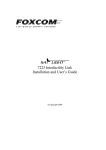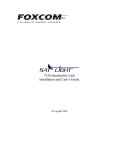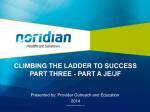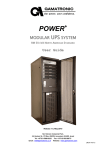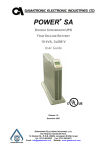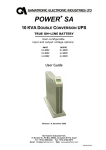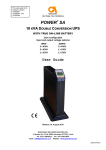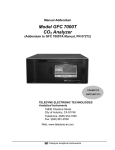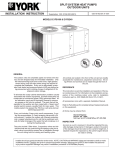Download 7000 Interfacility Link Installation and User's Guide
Transcript
7000 Interfacility Link Installation and User’s Guide Copyright 1999 7000 IFL Installation and User’s Guide 7000 Interfacility Link Installation and User’s Guide OnePath Networks Inc. 600 College Road East Princeton, New Jersey 08540 USA Tel: 609-514-1800 Toll Free: 1-800-OPNNET1 Fax: 609-514-1881 OnePath Networks Ltd. Beck Science Center 8 Hartom Street, Har-Hotzvim P.O. Box 45092 Jerusalem 91450 Israel Tel: +972-2-589-9888 Fax: +972-2-589-9898 Website: www.onepathnet.com e-mail: [email protected] This manual contains PROPRIETARY and CONFIDENTIAL information of OnePath Networks Inc. Reproduction, release to any third party, or any other unauthorized use, of any information contained herein is expressly prohibited. OnePath Networks Proprietary Information 2 Document No. 93-011-01B 7000 IFL Installation and User’s Guide Table of Contents 1. Front Chapter ...................................................................................................................... 5 1.1 Warranty and Repair Policy............................................................................................. 5 1.2 Reporting Defects............................................................................................................ 6 1.3 Certification..................................................................................................................... 6 1.4 Conventions..................................................................................................................... 7 1.5 Precautions ...................................................................................................................... 7 2. Introduction to the 7000 IFL.............................................................................................. 9 2.1 Options ............................................................................................................................ 9 2.2 Product Drawings .......................................................................................................... 11 2.3 Block Diagrams ............................................................................................................. 12 3. Installation ......................................................................................................................... 13 3.1 Setting Up...................................................................................................................... 13 3.2 The 7000 IFL Front Panels............................................................................................ 18 4. Product Specifications....................................................................................................... 19 4.1 7000 IFL Specifications................................................................................................. 19 4.2 Alarm and Monitor Pinouts........................................................................................... 21 4.3 Model Dimensions ........................................................................................................ 24 5. Gain Control ...................................................................................................................... 25 5.1 Transmitter Gain Control .............................................................................................. 25 5.2 Receiver Gain Control................................................................................................... 25 6. Trouble Shooting ............................................................................................................... 27 7. Appendix I Cleaning Fiberoptic Connections ................................................................ 29 8. Appendix II Installing a Standalone Unit ....................................................................... 29 OnePath Networks Proprietary Information 3 Document No. 93-011-01B 7000 IFL Installation and User’s Guide List of Figures Figure 1 - Option Sticker......................................................................................................... 10 Figure 2 - 7000 IFL Transmitter Front and Rear Panels ......................................................... 11 Figure 3 - 7000 IFL Receiver Front and Rear Panels .............................................................. 11 Figure 4 - 7000 Transmitter Block Diagram ........................................................................... 12 Figure 5 - 7000 Receiver Block Diagram................................................................................ 12 Figure 6 - Typical Application of a 7000 IFL ......................................................................... 13 Figure 7 - 7000 IFL Transmitter Pinout .................................................................................. 22 Figure 8 - 7000 IFL Receiver Pinout....................................................................................... 23 Figure 9 - Unit Dimensions ..................................................................................................... 24 Figure 10 - Chassis Dimensions .............................................................................................. 24 List of Tables Table 1 - 7000 Transmitter LEDs............................................................................................ 18 Table 2 - 7000 Receiver LEDs ................................................................................................ 18 Table 3 - 7000T Transmitter Pinout ........................................................................................ 22 Table 4 - 7000R Receiver Pinout ............................................................................................ 23 Table 5 - Receiver RF Signal Voltage..................................................................................... 26 Table 6 - Trouble Shooting the Transmitter ............................................................................ 27 Table 7 - Trouble Shooting the Receiver ................................................................................ 28 OnePath Networks Proprietary Information 4 Document No. 93-011-01B 7000 IFL Installation and User’s Guide Front Chapter 1. Front Chapter 1.1 Warranty and Repair Policy OnePath Networks performs testing and inspection to verify the quality and reliability of our products. OnePath Networks uses every reasonable precaution to ensure that each unit meets specifications before shipment. Customers are asked to advise their incoming inspection, assembly, and test personnel as to the precautions required in handling and testing our products. Many of these precautions are to be found in this manual. Nullification of Warranty The Warranty is null and void if the product casing is opened. The products are covered by the following warranties: A) General Warranty OnePath Networks warrants to the original purchaser all standard products sold by OnePath Networks to be free of defects in material and workmanship for one (1) year from date of shipment from Foxcom. During the warranty period, OnePath Networks will repair or replace any product that OnePath Networks proves to be defective. This warranty does not apply to any product which has been subject to alteration, abuse, improper installation or application, accident, electrical or environmental over-stress, negligence in use, storage, transportation or handling. B) Specific Product Warranty Instructions All OnePath Networks products are warranted against defects in workmanship, materials and construction, and to no further extent. Any claim for repair or replacement of units found to be defective on incoming inspection by a customer must be made within 30 days of receipt of shipment, or within 30 days of discovery of a defect within the warranty period. This warranty is the only warranty made by OnePath Networks and is in lieu of all other warranties, expressed or implied. OnePath Networks sales agents or representatives are not authorized to make commitments on warranty returns. C) Returns In the event that it is necessary to return any product against above warranty, the following procedure shall be followed: 1. Return authorization is to be received from OnePath Networks prior to returning any unit. Advise OnePath Networks of the model, serial number, and discrepancy. The unit may then be forwarded to Foxcom, OnePath Networks Proprietary Information 5 Document No. 93-011-01B 7000 IFL Installation and User’s Guide Front Chapter transportation prepaid. Devices returned collect or without authorization may not be accepted. 2. Prior to repair, OnePath Networks will advise the customer of our test results and any charges for repairing customer-caused problems or outof-warranty conditions etc. 3. Repaired products are warranted for the balance of the original warranty period, or at least 90 days from date of shipment. D) Limitations of Liabilities Foxcom's liability on any claim, of any kind, including negligence for any loss or damage arising from, connected with, or resulting from the purchase order, contract, quotation, or from the performance or breach thereof, or from the design, manufacture, sale, delivery, installation, inspection, operation or use of any equipment covered by or furnished under this contact, shall in no case exceed the purchase price of the device which gives rise to the claim. EXCEPT AS EXPRESSLY PROVIDED HEREIN, ONEPATH NETWORKS MAKES NO WARRANTY, EXPRESSED OR IMPLIED, WITH RESPECT TO ANY GOODS, PARTS AND SERVICES PROVIDED IN CONNECTION WITH THIS AGREEMENT INCLUDING, BUT NOT LIMITED TO, THE IMPLIED WARRANTIES OF MERCHANTABILITY AND FITNESS FOR A PARTICULAR PURPOSE. ONEPATH NETWORKS SHALL NOT BE LIABLE FOR ANY OTHER DAMAGE INCLUDING, BUT NOT LIMITED TO, INDIRECT, SPECIAL OR CONSEQUENTIAL DAMAGES ARISING OUT OF OR IN CONNECTION WITH FURNISHING OF GOODS, PARTS AND SERVICE HEREUNDER, OR THE PERFORMANCE, USE OF, OR INABILITY TO USE THE GOODS, PARTS AND SERVICE. 1.2 Reporting Defects The units were inspected before shipment and found to be free of mechanical and electrical defects. Examine the units for any damage which may have been caused in transit. If damage is discovered, file a claim with the freight carrier immediately. Notify OnePath Networks as soon as possible. Refer to Warranty and Repair Policy for further details. Note Keep all packing material until you have completed the inspection. 1.3 Certification The 7000 IFL has CE, FCC, FDA, and UL Certification. OnePath Networks Proprietary Information 6 Document No. 93-011-01B 7000 IFL Installation and User’s Guide Front Chapter 1.4 Conventions In this manual the following special formats are used: Note Notes contain information detailing the current topic. CAUTION Cautions contain information regarding situations or materials which could damage your product. WARNING WARNINGS CONTAINS INFORMATION REGARDING DANGEROUS FUNCTIONS. 1.5 Precautions 1.5.1 Personal Safety WARNING OPTICAL RADIATION APPLYING POWER TO THE TRANSMITTER UNIT WILL CREATE A LASER ENERGY SOURCE OPERATING IN CLASS I AS DEFINED BY IEC 825-1. USE EITHER AN INFRARED VIEWER, OPTICAL POWER METER OR FLUORESCENT SCREEN FOR OPTICAL OUTPUT VERIFICATION. AC POWER HAZARD THE RACKMOUNT POWER SUPPLY LINE IS EMI FILTERED AND FUSED. THE CHASSIS IS CONNECTED TO EARTH GROUND IN COMPLIANCE WITH SAFETY REQUIREMENTS. ALWAYS USE THE 3 PRONG AC PLUG WITH EARTH GROUND TO AVOID POSSIBILITY OF ELECTRICAL SHOCK HAZARD TO PERSONNEL. OnePath Networks Proprietary Information 7 Document No. 93-011-01B 7000 IFL Installation and User’s Guide Front Chapter 1.5.2 Equipment Safety To avoid damaging your product, please observe the following: 1. Fuses: To avoid possibility of fire hazard, always replace fuses with the same type and rating of fuse as recommended on the power supply rear label. 2. The input of the transmitter has an optional built-in bias for inserting DC power up the coax to the LNB. Make certain any equipment or test equipment connected to the transmitter input can withstand this bias. 3. The output of the receiver is AC coupled and can withstand the bias from a satellite receiver. Do not exceed 25V DC bias. 4. Do not allow any dirt or foreign material to get into the optical connector bulkheads. This may cause damage to the polished optical connector end faces. 5. The optical fiber jumper cable bend radius is 3 cm. Smaller radii can cause excessive optical loss and/or fiber breakage. 6. If multiple transmitters are installed in the chassis allow sufficient room for adequate ventilation; otherwise the units may overheat causing possible safety hazard or equipment damage. 7. When several units are installed on one 7000M chassis, ensure that the total units current (including any LNB bias) does not exceed 2A per power supply. OnePath Networks Proprietary Information 8 Document No. 93-011-01B 7000 IFL Installation and User’s Guide Introduction to the 7000 IFL 2. Introduction to the 7000 IFL The SAT-LIGHT 7000 IFL transmits an entire L-Band over singlemode fiber from a satellite antenna LNB to control room equipment up to 10 kilometers away while preserving excellent signal quality. The 7000 IFL consists of an optical transmitter (7000T) which receives the L-Band signal from the LNB and an optical receiver (7000R) which connects to a satellite receiver. The 7000T and 7000R modules plug into a 7000M 3U chassis/power supply that enables expansion of the system to accommodate any 6 SAT-LIGHT modules. Accessories include the Model 7000S Standby Power Supply, the Model 2000 1:1 Redundant Switch, the Model 2100 Amplifier, the Model 2200 Splitter, and the Model 7050-4 Serial Data Multiplexer, an asynchronous data link. The 7000 IFL is a broadband transmission link; all standard satellite modulation formats can be transmitted (i.e. QPSK, FM, etc.). The RF signal is directly modulated and adds virtually no phase noise to the original signal. The direct modulation, coupled with the 7000 Links RF circuitry, guarantees superior signal quality. The 7000 IFL is capable of more than 35 dB carrier to noise performance in a full band or single carrier environment. The 7000 IFL features both Automatic Gain Control (AGC) and Manual Gain Control (MGC). AGC at transmitter site sets and maintains optimum operation over a wide range of input signal levels. At the receiver site AGC maintains the RF level regardless of optical power or distance from the transmission site. Front panel RF tests ports, LEDs, and back panel monitors and alarms allow for complete system status monitoring and for interfacing with M & C systems. Featuring a Multi-Quantum Well (MQW) laser diode, the 7000 IFL operates over a wide temperature range, without needing to be cooled. The transmitter unit can provide 15 VDC for optional LNB powering. 2.1 Options The 7000 IFL comes with a variety of options: 1. LNB powering - The transmitter unit can provide 15 VDC for optional LNB powering. 2. 50 Ω Input-Output Impedance/BNC RF connector. Standard impedance is 75 Ω/F type, female connectors are standard. 3. Extended frequency - 950 to 2500 MHz. The standard bandwidth is 950 - 2150 MHz. 4. Standalone unit - The 7000 IFL can be installed as a standalone unit. If the 7000 is used as a standalone, a separate power supply must be used. OnePath Networks Proprietary Information 9 Document No. 93-011-01B 7000 IFL Installation and User’s Guide Introduction to the 7000 IFL On the side of the 7000T and the 7000R units is a sticker1 which lists options 1 to 3. Under each option is a square. If the unit includes a particular option the square under the option should be marked. Options 1550 LNB 50 25 Figure 1 - Option Sticker 1 The sticker includes options which are not relevant to the 7000 IFL. OnePath Networks Proprietary Information 10 Document No. 93-011-01B 7000 IFL Installation and User’s Guide Introduction to the 7000 IFL 2.2 Product Drawings Figure 2 shows the front and rear panels of the 7000 IFL Transmitter units. Figure 2 - 7000 IFL Transmitter Front and Rear Panels Figure 3 shows the front and rear panels of the 7000 IFL Receiver units. 7000R Figure 3 - 7000 IFL Receiver Front and Rear Panels OnePath Networks Proprietary Information 11 Document No. 93-011-01B 7000 IFL Installation and User’s Guide Introduction to the 7000 IFL 2.3 Block Diagrams Figure 4 - 7000 Transmitter Block Diagram Figure 5 - 7000 Receiver Block Diagram OnePath Networks Proprietary Information 12 Document No. 93-011-01B 7000 IFL Installation and User’s Guide Installation 3. Installation The following section details: • How to setup the 7000 IFL units • The 7000 IFL Front Panels 3.1 Setting Up2 Setting up the 7000 IFL Transmitters and Receivers consists of the following steps: 1. Setting up the transmitter. 2. Connecting the fiberoptic cable. 3. Setting up the receiver. 4. Monitoring the input/output signal. 5. Powering the IFL. Observe all warnings and cautions mentioned at the beginning of this manual (page 7). If after set-up you experience problems, refer to Trouble Shooting on page 27. Figure 6 - Typical Application of a 7000 IFL 2 This section gives instructions on installing the transmitter and receiver in a chassis rackmount. For instructions on installing a standalone unit refer to Appendix II Installing a Standalone Unit. OnePath Networks Proprietary Information 13 Document No. 93-011-01B 7000 IFL Installation and User’s Guide Installation 3.1.1 Setting Up the Transmitter 1. Place the 7000T in the 7000M Chassis. The operating base plate temperature must be between -10° C to 55° C. 2. Apply AC power to the chassis. The Power Supply’s LED should be lit. 3. Mount the 7000T into the chassis. The Laser LED should be lit. 4. Using an optical power meter, measure the optical power. Insert the meter’s cable into the Transmitter’s optical connector. Power levels should be between 0.4 - 1.0 mW. Alternatively, use a DVM to measure the voltage at pin #6 on the back panel connector. The power level should be -4.5 ± 0.2 VDC. 5. On the rear panel, connect the coax cable to the RF Input Connector. 6. On the rear panel, connect the fiberoptic cable to the Optical Connector. 7. On the Transmitter front panel, switch the Gain Control toggle switch to Auto3 (refer to Figure 2). The AGC LED should be lit. Note If either LED is not lit, refer to Trouble Shooting on page 27. 3 Transmitter AGC is factory set to give optimal performance at an input power of -20 to -40 dBm. If the input power is outside of this range MGC should be used. Refer to Transmitter Gain Control on page 25. OnePath Networks Proprietary Information 14 Document No. 93-011-01B 7000 IFL Installation and User’s Guide Installation RF Interference Strong "out-of-band" signals, (i.e. microwave communications, cellular phone sites or other interferences etc.) present and detected by the 7000T input AGC may cause internal level changes. These level changes may cause the link signal to noise and total power to change in real time. Verify any interfering signals by switching the Gain Control to MGC mode and checking the transmitter RF test point with a spectrum analyzer. 3.1.2 Connecting the Fiberoptic Cable Before connecting the cable: 1. The fiberoptic cable must be either fusion spliced or connected via FC/APC connectors. 2. Wipe the connector with a lint-free cotton cloth. 3. Note the polarity key of the optical connector before inserting. To connect the cable: 1. Line Up the Polarity Key. 2. Insert the connector. 3. Tighten the connector. OnePath Networks Proprietary Information 15 Document No. 93-011-01B 7000 IFL Installation and User’s Guide Installation 3.1.3 Setting Up the Receiver 1. Place the 7000 Receiver in the 7000M Chassis. The operating base plate temperature must be between -10° C to 55° C. 2. Apply AC power to the chassis. The Power Supply’s LED should be lit. 3. Mount the 7000R into the chassis. 4. On the rear panel connect the fiberoptic cable to the Optical Connector. The Opt. LED should be lit. 5. Using an optical power meter, measure the optical power coming to the Receiver from the fiberoptic cable. The power levels of the Receiver should be the power level measured at the Transmitter minus the fiber loss4. Alternatively, use a DVM to measure the voltage at pin #6 of the D type connector. The power level should be 1V to each 1 mW measured at the Receiver input. 6. On the rear panel, connect the fiberoptic cable to the Optical Connector. The Opt. LED should be lit. 7. On the rear panel, connect the coax cable to the RF Output Connector. 8. On the Receiver front panel, switch the Gain Control toggle switch to Auto (refer to Figure 3). The AGC LED should be on. 9. The Receiver AGC is factory set at -30 dBm RF Signal Output Total Power. If the user’s application requires a different Output Power, refer to Receiver Gain Control on page 25. Note If either LED is not lit, refer to Trouble Shooting on page 27. RF Interference The AGC is sensitive to strong signals which may leak in from the 7000R output connector. If these leakage signals enter from the connecting equipment you may have to pad the 7000R output with a 20 dB pad and increase the gain of the 7000R. 4 Fiber loss is defined as: (0.4 dB/km x length (km) of the fiberoptic cable) + (0.5 dB x number of connectors). For example if a link was 10 kilometers long and had two connectors the loss would be: (0.4 dB/km x 10 km) + (0.5 dB x 2) = 5.0 dB. A 6 dB loss is equivalent to a 4 times loss (i.e. 25% of original launched power) OnePath Networks Proprietary Information 16 Document No. 93-011-01B 7000 IFL Installation and User’s Guide Installation 3.1.4 Powering the IFL • Transmitter power requirement - 15VDC @ 300 mA (excluding LNB Drive option) Receiver power requirement - 15VDC @ 280 mA The Standalone Transmitter/Receiver can be powered by a Foxcom-supplied external DC power supply. The Rackmount Transmitters/Receivers are plugged into the 7000M rackmount chassis. The chassis can accept and power up to six units. • • • Note At temperatures below 10° C, the Transmitter’s internal heater will require an additional 100 mA. The Transmitter’s total power requirement will then be 400 mA. CAUTION Ensure that there is a good airflow around the chassis rackmount. 7000M Chassis The 7000M Chassis provides power to the plug in units. The power supply is a linear unregulated type. Each plug-in regulates its own voltage. The 7000M provides: • • • • 15 to 18 VDC (unregulated) @ 2.2 amps power AC input @ 110/220 VAC (user selected) Units can be plugged in “hot standby” An internal 5 amp fuse 7000S (optional) Hot standby power supply For applications demanding the utmost in reliability and uptime, the 7000S standby power supply can be optionally plugged in to the standard chassis. The 7000S features hot swapping - supplies may be installed and removed even during operation. Each power supply is fully redundant and can power a completely loaded chassis on its own should its "partner" fail. During normal operation the two units share the load by means of current steering diodes located on the rear panel. OnePath Networks Proprietary Information 17 Document No. 93-011-01B 7000 IFL Installation and User’s Guide Installation 3.1.5 Monitoring the Input/Output Signal On the front panel of the 7000T Transmitter and the 7000R Receiver is a female F Connector. This connector, which is labeled RF Test, is used to monitor the Input RF signal sent to Transmitter laser, and the RF output signal from the Receiver. To monitor the signal: 1. Using coax cable, connect the RF Test Port to the test equipment. 3.2 The 7000 IFL Front Panels On the Front Panel of the 7000 Transmitter and Receiver unit are LEDs. The following tables describe the LEDs. Table 1 - 7000 Transmitter LEDs LED Name Laser AGC LED Function Indicates if the optical output power control is functioning Indicates if the Automatic Gain Control is within operating limits Table 2 - 7000 Receiver LEDs LED Name Optical Power AGC LED Function Indicates if the optical reception power is within limits Indicates if the Automatic Gain Control is within operating limits Note When MGC is selected the AGC LED can be on or off. However the LED has no significance. OnePath Networks Proprietary Information 18 Document No. 93-011-01B 7000 IFL Installation and User’s Guide Product Specifications 4. Product Specifications • 7000 IFL specifications • Alarm and Monitor Pinouts • Model Dimensions 4.1 7000 IFL Specifications RF Characteristics Frequency Range Flatness 950 - 2150 MHz (dB) Flatness 950 - 2500 MHz (dB) Flatness @ any 36 MHz Input/Output Impedance Return Loss Intermodulation Products5 Input Signal Range (Total Power)6 Output Signal Range (Total Power) CNR @ 36 MHz / 10 km Long Term Stability Temperature Stability Gain Control Link Gain RF Connector Optical Characteristics Optical Wavelength Optical Power Output Optical Connector Singlemode Fiber Loss Optical Budget/Distance Optical Return Loss 950 -2150 MHz (2500 MHz optional) ±1.5 (typical); ± 2.0 (max.) ± 2.5 (max.) ± 0.25 (max.) 75 Ω (50 Ω option) 13 dB -40 dBc (max.) -40 to -20 dBm -40 to -15 dBm 35 dB for single channel ± 0.1 dB ± 2 dB over full temperature range Manual or Automatic 0 ± 10 dB F type female (SMA Option) 1310 ± 10 nm -3 dBm (min.) to 0 dBm FC/APC 0.4 dB/km typical 6 dB/10 km -50 dB 5 At nominal conditions 6 Roughly equivalent to 10 channels of FM @ -50 to -30 dBm/channel OnePath Networks Proprietary Information 19 Document No. 93-011-01B 7000 IFL Installation and User’s Guide Miscellaneous Chassis Capacity Chassis Size Unit size Power for Chassis Power for Standalone Transmitter Receiver Operating Temperature Range Storage Temperature OnePath Networks Proprietary Information Product Specifications 6 Plug-ins 19” x 5.25” x 7.3” 5” x 4.8” x 1.6” 110 or 220 VAC 60 Watts (max.) 15 VDC @ 300 mA (max.) (400 mA <100 C) 15 VDC @ 270 mA (max.) -10° C to 55° C -20° C to 85° C 20 Document No. 93-011-01B 7000 IFL Installation and User’s Guide Product Specifications 4.2 Alarm and Monitor Pinouts The unit’s alarm & monitor pins are found at the back plane of the 7000M chassis. On standalone units, access to alarms & monitors is via the 9 pin D-type power connector. The 7000M backplane incorporates 6 slots, each of which has its own 6 pin blank header associated with it. Any monitor voltages to be measured may be done between the chassis and the required pin. The pins are numbered as follows: 6 5 4 3 2 1 OnePath Networks Proprietary Information 21 Document No. 93-011-01B 7000 IFL Installation and User’s Guide Product Specifications Table 3 - 7000T Transmitter Pinout Rackmount 6 Pin Back Panel Connector Standalone 9 Pin Connector 1 2 3 4 4 5 6 6 1 7 2 8 3 9 5 Function Description +15V Power Not Used Power Ground RF Signal Strength Monitor PDI 300 mA7 (excluding LNB Option) DC Return RF Signal Strength Indicator; Range 0.2 - 10V8 Measures Laser Optical Power; Range -3 to -4V Laser Current Monitor Measures Laser Bias; Range -4.5 ± 0.2V AGC Alarm Sinks current at low optical up to 30 mA LSR Alarm Sinks current at low optical up to 30 mA LNB Bias External LNB Bias +13 to +18V 7000T Transmitter 9 Pin D-Type Male Connecter Not Used 1 2 RF Signal Strength Monitor Laser Photodiode Current Monitor Laser Current Monitor AGC Alarm 3 4 5 6 7 LSR Alarm 8 9 +15V Power Power Ground External LNB Bias Figure 7 - 7000 IFL Transmitter Pinout 7 400 mA below 100 C 8 AGC set point is 2.5V ± 0.5 OnePath Networks Proprietary Information 22 Document No. 93-011-01B 7000 IFL Installation and User’s Guide Product Specifications Table 4 - 7000R Receiver Pinout Standalone 9 Pin Connector 1 2 3 4 Rackmount 6 Pin Back Panel Connector Function Description DC 280 mA 6 +15V Power Not Used Power Ground RF Signal Strength Monitor Optical Power Monitor 4 5 6 7 1 2 Spare AGC Alarm 8 3 Optical Power Alarm 9 5 Spare DC Return RF Signal Strength Indicator; Range 0.25 to 10V9 1V/mW Optical Power Received Not Used Sinks current at loop unlock up to 30 mA Sinks current at low optical up to 30 mA Not Used 7000R Receiver 9 Pin D-Type Male Connecter Not Used RF Signal Strength Monitor Optical Power Monitor Not Used AGC Alarm Optical Alarm Not Used 1 2 3 4 5 6 7 +15V Power Power Ground 8 9 Figure 8 - 7000 IFL Receiver Pinout CAUTION When monitoring the voltage outputs use a high resistance DVM only. 9 Nominal Voltage in AGC Mode - 3.0V OnePath Networks Proprietary Information 23 Document No. 93-011-01B 7000 IFL Installation and User’s Guide Product Specifications 4.3 Model Dimensions Figure 9 - Unit Dimensions 0.12“ FRONT VIEW 1.52’‘ “ REAR VIEW Figure 10 - Chassis Dimensions OnePath Networks Proprietary Information 24 Document No. 93-011-01B 7000 IFL Installation and User’s Guide Gain Control 5. Gain Control All internal adjustments have been set up at the factory; the only user adjustments are input and output RF signal levels accessible from the front panel and described in the following sections. To adjust the gain: 1. Using a small screw driver, turn the gain control potentiometer (located on the front panel) to increase or decrease the gain. a. To increase the gain, turn the gain control clockwise. b. To decrease the gain, turn the gain control counterclockwise. Note The potentiometer is a 10 turn potentiometer. 5.1 Transmitter Gain Control The transmitter is normally operated in AGC mode. Using AGC no adjustments are required. If AGC is not desired, the MGC mode can be used. Since MGC sets a constant input gain to the laser, an initial setup is required to ensure the input signal level is not too high (overdriving the laser) or too low (poor carrier to noise). Once set in MGC input signal level variations are not automatically compensated for; the link will work, albeit without continuously optimizing performance. These variations can be caused by changes in dish pointing, rain fade or satellite channel loading, etc. To prevent under-driving or over-driving the laser the signal level must be between 2 to 5VDC. To set the MGC: 1. Adjust the MGC potentiometer while monitoring the RF signal voltage. The 7320 IFL is designed to provide optimal output at 2.5V ± 0.5V. Therefore regardless of the input the Manual Gain Control should be set to provide this output. 2. If there is input signal level variation expected, it is best to leave some "headroom" should the signal level become too strong and result in distortion. It is usually better to adjust the signal lower rather than higher. OnePath Networks Proprietary Information 25 Document No. 93-011-01B 7000 IFL Installation and User’s Guide Gain Control 5.2 Receiver Gain Control There are two ways to adjust the Receiver AGC or MGC: 1. The potentiometer is adjusted while monitoring the voltage of the Receiver "RF Sig." Monitor (Pin #4 on either Standalone or Rackmount units). Table 5 provides approximate settings for desired output levels. 2. Attach a test cable to the RF Test Port and a spectrum analyzer. Turn the potentiometer until you reach the desired output power. Table 5 - Receiver RF Signal Voltage RF Output Level (dBm) 10 -20 -25 -30 -35 -40 10 RSSI (volts) ± 10% 10.5 7.5 2.75 (factory setting) 1.2 0.6 Total Output Power OnePath Networks Proprietary Information 26 Document No. 93-011-01B 7000 IFL Installation and User’s Guide Trouble Shooting 6. Trouble Shooting The 7000 IFL was tested before it left the factory. However if you are experiencing difficulties consult the list below for possible solutions. If your system is still experiencing problems, please attempt to isolate and identify the malfunctioning unit. Table 6 - Trouble Shooting the Transmitter PROBLEM POSSIBLE CAUSE 1. Laser LED is not on 1. No DC power to the unit. Possible power supply problem or AC power input problem. Check the fuse. 2. Verify LSRI monitor is between -4.8 and -4.2V. If not, laser may have overheated. Disconnect power or remove plug in and allow to cool. Try again with better airflow. 3. If optical power meter is available, measure optical power out of the transmitter. The power should be 0.4 mw to 1 mw. If no optical power meter is available, then use another receiver to determine if there is optical power emerging from the transmitter (use the 5 meter jumper cable). If there is no optical power, then the transmitter unit is malfunctioning. If any or all the above are not within the guidelines, the transmitter unit is faulty. 2. Transmitter AGC LED is illuminated in MGC mode. No problem. The AGC LED has no meaning in MGC mode. (Turn the AGC potentiometer all the way to either side and the LED should extinguish.) 3. In AGC mode the LED is not illuminated. 1. The input signal is out of range (either too high or too low); verify signal out of the RF Test Point or RF signal strength Pin #4. Even if slightly out of range, the unit may still function, although you will register an alarm condition. 2. AGC circuit is not working use MGC and/or contact factory. 4. AGC LED illuminated with no input signal. Unit may be receiving stray RF "Pick Up". Solution: Provide RF input or use 75 Ω termination at input. OnePath Networks Proprietary Information 27 Document No. 93-011-01B 7000 IFL Installation and User’s Guide Trouble Shooting Table 7 - Trouble Shooting the Receiver 1. Lack of RF signal present at Receiver, yet optical power is functioning. 1. If the unit has an LNB drive option, verify correct LNB bias is coming down the center of the RF connector at the transmit site. 2. Verify dish is pointed and correctly receiving satellite signals. 3. Set gain switch to manual, and check for signal present at RF Test point at Transmitter (assuming spectrum analyzer is available). If a spectrum analyzer is not available then use RF Signal Strength Pin #4 and adjust the MGC for a reading of 3.5V. Conclusion: If signal still not present then transmitter input stage amplifier is defective. Contact factory. 2. No optical power, LED not illuminated. 1. Transmitter is not functioning, see above. 2. There is a break or severe bend in the fiber optic cable. Use an optical power meter or another functioning receiver unit to verify optical power coming down the fiber. 3. Optical power too low, too many splits, too long a distance (thus exceeding optical budget). System may still function without LED illuminated although at reduced performance. Leaky photodiode or DC Amplifier offset. Unit may still function, 3. Optical power light otherwise contact factory for service. illuminated with disconnected optical input. 4. Receiver AGC LED is illuminated while in MGC mode. No problem, the AGC Led has no meaning in MGC mode. Turn the AGC potentiometer all the way to either side and the LED should extinguish. 5. In AGC mode the LED is not illuminated. 1. The input signal is out of range (either too high or too low); check RF Test Point to verify signal output. 2. AGC circuit is not working, use MGC and/or contact factory. 6. In AGC mode the LED flickers. 1. Almost out of range of the AGC. 2. Stray RF signals leaking back into the optical receiver unit from the satellite receiver or other attached equipment - use MGC or 'pad' the optical receiver output. OnePath Networks Proprietary Information 28 Document No. 93-011-01B 7000 IFL Installation and User’s Guide Appendix I Cleaning Fiberoptic Connections 7. Appendix I Cleaning Fiberoptic Connections The unit has an FC/APC (or other optional) angle polished optical connector for very high optical return loss performance. The units are specified into singlemode fiber i.e. 9/125 micron core diameter. Full performance is specified only for low return loss optical plant meaning that the fiber must be fusion spliced and all connections or splices must have a return loss greater than -60 dB. With these guidelines in mind, link lengths beyond 20 kilometers (DFB based products) can be achieved with high performance. Specific performance and/or design assistance is available by request from Foxcom. If there is low/no signal or noisy signal at a OnePath Networks module, the connector should be cleaned. Dirt on the inside connector tip can impair the flow of light causing problems in signal transmission. OnePath Networks modules are sealed but dirt can occasionally enter during installation and alignment. 8. Appendix II Installing a Standalone Unit To install the 7000T-STD or 7000R-STD: 1. Place the 7000 unit on the standalone flange, matching the holes. 2. Using four screws (#4 or #6) secure the unit and the flange to the wall. 3. Apply AC power to the standalone power supply unit. 4. Connect the 7000 unit to the power supply. The Laser LED should be lit. 5. All remaining steps are the same. Refer to Setting Up the Transmitter on page 14, and Setting Up the Receiver on page 16. OnePath Networks Proprietary Information 29 Document No. 93-011-01B





























